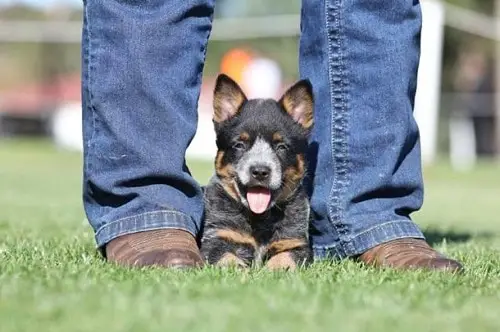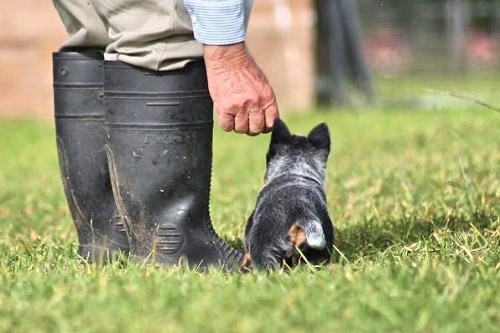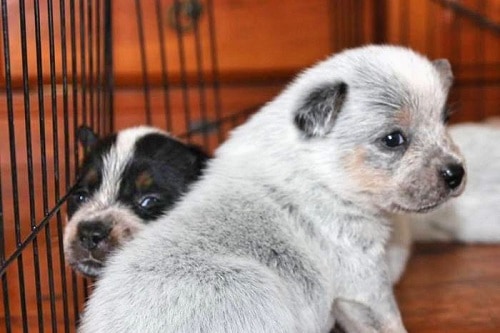Socialization of your Australian Cattle Dog puppy is vitally important to his future and wellbeing. Along with potty training, socialization could very well be the most important focus for you as your puppy begins to mature.
Socialization is simply exposing your puppy to the sights and sounds of the world without anything bad happening. Little by little, day by day, the puppy sees and accepts new sights, sounds, smells, people, objects and other dogs.
Most trainers and breeders agree that Australian Cattle Dog socialization really starts as early as a puppy’s first three weeks of age. This is when the breeder should gently handle and talk to the puppy.
If done often, quietly and on a regular basis, the puppy will get used to being handled and touched all over and, at the same time, will learn to appreciate the human voice.
From this period through the puppy’s third month of life is the most important time to meet as many new people as possible and to experience lots of situations and environments.
This is the time of his life when he will be more curious and accepting of new things rather than being fearful.
Images Credit: Belinda Carter, Erudite Australian Cattle Dogs

Socialization vs Training-What's the difference?
Socialization is a term that gets used and written about over and over but perhaps without a good understanding or explanation of what it really is.
Australian Cattle Dog Socialization
Socialization, in general, is different than what we think of as training. Dogs can be socialized quite nicely without ever being trained. And, dogs can be trained without ever being socialized.
How is that, you might ask. Well, think about the dog that behaves very well at home. He will sit, stay, come and fetch. While in his own back yard he seems to listen and obey nicely. But if you go to a dog park, or go for a walk around the neighborhood, he is scared to death, pulls on the leash and misbehaves badly. He is a dog that has been trained but never really socialized.
Then there is the dog that seems to love everyone, is never afraid and always seems to be calm and at ease. Yet he has no idea what sit, stay or come means. He could have been socialized but never actually trained.
Think of socialization as becoming OK with the world, or, becoming desensitized to new situations or scary objects to the point of just being ok with everything. He is just laid back and cool!
The really social dog will be able to go wherever you go, meet new people and be in new situations without becoming afraid, barking, trying to pull away or attacking anyone.
Training, on the other hand, can be thought of as learning to perform tasks and follow commands.
The point is that socialization is not necessarily the same thing as training. Each has its own place in the development of a well rounded puppy. While there is some overlapping, each needs to be approached with separate intent.

An example of Australian Cattle Dog socialization
Maybe you are out for a walk when your puppy sees something at a distance that catches his eye and causes him concern. That’s known as the approach. (The act of getting closer to the cause of his concern).
The first thing that he will do is to stop in his tracks and look at it. He is concerned enough about it that he doesn’t want to get any closer just now.
The worst thing that you can do is to start talking baby-talk and trying to drag or pull him closer to it in order to show him that there is nothing to worry about. He is already worried, and there is nothing you can say or do to make him change his mind.
What you should do is: nothing.
Just wait, let him decide if he wants to continue, stand still, or turn back. Turning away is fine. To retreat, means to walk away, or go somewhere else, and when he is no longer bothered or concerned, return and try it again.
(Your job is to advocate for your puppy, to be his protector.)
Because the last approach was fairly uneventful and nothing bad happened, the next time he might get a little closer before feeling any concern.
Do the same thing that you did the first time, showing him that it is no big deal. After a time or two quit. Go somewhere else, make it fun, play or even give him a treat.
The fact that he had a good experience, nothing bad happened, he lived through it, and had a fun time doing it, will make it easier for you to repeat the same thing tomorrow. As time goes on, each day, he will be able to get closer and closer without being concerned.
The important thing is: don’t be in a hurry, don’t scare him, go slow and easy, keep it happy and positive, and remember, tomorrow is another day!
Don’t ever try to do it all at once.
Using Approach and Retreat.
The above example gives a good description of how approach and retreat would work during Australian Cattle Dog socialization.
You are slowly approaching an object until the puppy notices it and becomes the slightest bit concerned by it. Then, without force, or without causing stress, you retreat. The retreating shows him that it is no big deal, there is no reason for concern, and that he has the ability to move away to safety.
Doing this will prevent the feeling of panic because he will never feel trapped.
It is very important to be aware of the concern level and to be willing to retreat before concern turns into fear.
Approach and retreat allows you to take your time with socialization and to break the process down into small steps.

Australian Cattle Dog socialization happens at a very young age.
What Socialization IS NOT.
Australian Cattle Dog socialization is NOT trying to force your puppy to accept things that scare him. It is totally natural for your puppy to be standoffish and to show some fear when confronted with something that he is not familiar with.
When approaching a scarry object, an unfamiliar person, or dog that he does not know, the worst thing you can do is try to force acceptance. Once he starts showing concern or a slight fear of something, never be forceful.
It is a good idea to back away from what is causing concern rather than try to get too close too soon. In other words, retreat rather than approach.
Socialization starts from a distance. It does not have to always be within touching distance.
Socialization is also NOT trying to get your puppy nose to nose with a lot of other dogs or expecting them to play nicely together. Most puppies or adults that growl or bark at other dogs do so out of fear. Forcing dogs to be too close together will cause an increase in fear and make matters worse.
Remember, especially when around other dogs, your job is to protect your puppy.
Some dogs are easier to socialize than others.
There can be large differences between dog breeds in how easy or how hard socialization can be. There can also be differences between certain individuals within a breed.
Dogs that are more cautious or fearful will take more time and understanding to accept certain things than a more laid back dog or breed.
To be successful at Australian Cattle Dog socialization you need to become aware of the breed’s special needs, and adjust your methods as needed. You may have to take smaller steps and go slower than with other breeds.

How does age affect socialization?
As puppies get older the window of opportunity for socialization diminishes.
The best and most effective age for Australian Cattle Dog socialization is from 2-4 months, or from 8-16 weeks of age. This is the time period when their curiosity is high enough to overcome any fear that they may have.
Granted, at this age they will not have all of their puppy shots yet. However, there are still plenty of ways to accomplish socialization without exposing your puppy to dangerous situations.
Important ideas to apply to Australian Cattle Dog socialization.
- Break Australian Cattle Dog socialization tasks down into small steps.
- Consider breaking the small steps down into even smaller steps.
- Always keep it positive.
- Never be in a hurry.
- Don’t be forceful.
- Let the puppy advance at his own rate.
- Acceptance can never be forced.
- Learn to recognize signs of stress.
- Don’t let the process become overwhelming.
- Work on socialization a little bit every day.
- Try to meet as many new people as possible, but don’t let them scare him by trying to touch him if he is not ready yet.
- Your puppy does NOT have to be friends and play with all dogs.
- Practice approach and retreat in every new situation.
What if your dog has a bad experience during socialization?
Things can happen quickly, and try as you might, sometimes plans go wrong.
If, while you are working on your Australian Cattle Dog socialization, you have a bad experience, it can damage your puppy both physically and mentally.
Maybe you are doing your best and an unleashed dog comes from nowhere and attacks yours. Even without any physical damage an attack like this could scare your puppy to the point that it will take quite a while to get over it.
He could be scared to the point that he overreacts every time he sees another dog.
Paws and Reflect is a web site written by Sean and Haley all about the life that they share with their Australian Cattle Dog Scout.
One day Scout was attacked in exactly that same way. In Haley’s own words:
“We were walking down the sidewalk. I saw a dog and owner up ahead, and — as I’d done in the past, believing it was the right move — decided to think nothing of it.
When we walked by, the other dog pulled to the end of his flexi lead. He lunged at Scout, pinning her to the ground almost instantly. To this day, I’ve never heard her yelp so loudly. She cried. They flailed. I felt my blood freeze and then boil.
When the other owner finally dragged her dog away, I was at a complete loss.
Scout wasn’t physically hurt — there was no blood on her speckled coat — but she was never the same mentally.
In the next few days, I tried again to “not make a big deal of things”. My motto: act like nothing happened. We saw a few more dogs without huge incident, but we were both shaken.
And finally, once Scout saw that I wasn’t going to do anything about keeping other canines away, she took it upon herself.
Her reactivity emerged full force.”
Scout had been attacked, became extremely fearful, and as a result began to be reactive whenever she saw another dog.
Bringing a fearful, reactive dog back from an experience like this takes a lot of love and patience.
You will also find a lot more good information to learn about Australian Cattle Dog socialization, basic training philosophy, and much more.
One last thought about Australian Cattle Dog socialzation
If you are having trouble or problems and feeling frustrated while working on Australian Cattle Dog socialization, do not hesitate to find professional help.

